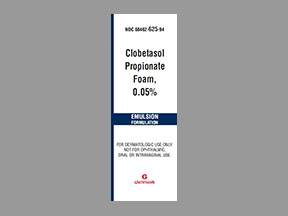My prescription
Edit
100GM of 0.05%, Clobetasol Emulsion (1 Can)
Select pharmacy

CVS
$43.60
COUPON PRICE
Albertsons
$70.29
COUPON PRICE
Walgreens
$167.31
COUPON PRICE
Walmart
$220.97
COUPON PRICEClobetasol Emulsion savings card
Show this card to your pharmacist
CVS
$43.60
BIN
ID
PCN
GRP
015995
LHEY038780
GDC
GDRX
Powered by
More prescriptions for skin allergy
More prescriptions for skin allergy
Clobetasol Emulsion dosage forms
Dosage Quantity Price from Per unit 100GM of 0.05% 1 Can $100.80 $100.80 100GM of 0.05% 2 Cans $191.60 $95.80 100GM of 0.05% 3 Cans $274.40 $91.47 100GM of 0.05% 4 Cans $357.20 $89.30 100GM of 0.05% 6 Cans $522.80 $87.13
| Dosage | Quantity | Price from | Per unit |
|---|---|---|---|
| 100GM of 0.05% | 1 Can | $100.80 | $100.80 |
| 100GM of 0.05% | 2 Cans | $191.60 | $95.80 |
| 100GM of 0.05% | 3 Cans | $274.40 | $91.47 |
| 100GM of 0.05% | 4 Cans | $357.20 | $89.30 |
| 100GM of 0.05% | 6 Cans | $522.80 | $87.13 |
Clobetasol Emulsion Warnings
When using clobetasol emulsion, it's important to be aware of certain risks to ensure safe and effective treatment. This medication is a potent topical corticosteroid, and improper use can lead to serious health concerns.
One significant risk is the suppression of the hypothalamic-pituitary-adrenal (HPA) axis. This occurs when the body absorbs the medication through the skin, potentially leading to decreased production of natural corticosteroids. Symptoms of HPA axis suppression may include fatigue, low blood pressure, and dizziness. To minimize this risk, it's crucial to use clobetasol emulsion exactly as prescribed, avoiding application over large areas or for extended periods.
Another concern is the development of Cushing's syndrome, a condition characterized by an excess of corticosteroids in the body. Signs include weight gain, a rounded face, and high blood pressure. This can result from prolonged use of clobetasol emulsion, especially when applied under occlusive dressings or on compromised skin.
Additionally, using clobetasol emulsion may increase the risk of developing cataracts or glaucoma. If you experience visual disturbances such as blurred vision or eye pain during treatment, consult your healthcare provider promptly.
Certain individuals should exercise caution or avoid using clobetasol emulsion altogether. This includes those with known allergies to clobetasol or other corticosteroids, individuals with active skin infections, and patients with conditions like rosacea or perioral dermatitis. Furthermore, due to the potential for increased absorption and adverse effects, clobetasol emulsion is generally not recommended for use in children under 12 years of age.
To ensure safety, do not use clobetasol emulsion on the face, groin, or underarms unless directed by your doctor. Avoid covering the treated area with bandages or wraps unless instructed, as this can increase absorption and the risk of side effects. Always wash your hands after applying the medication to prevent unintentional spread to other areas.
By adhering to these guidelines and maintaining open communication with your healthcare provider, you can effectively manage your condition while minimizing potential risks associated with clobetasol emulsion.
Clobetasol Emulsion Side Effects
Common side effects:
- burning
- itching
- irritation
- dryness
- acne
- unusual hair growth
- folliculitis
Less common but important to monitor:
- redness
- swelling
- unusual tiredness
- weight loss
- headaches
- swelling in the ankles or feet
- increased thirst or urination
- vision problems
Serious side effects:
- stretch marks
- changes in skin color
- changes in skin thickness
- rash
- severe itching or swelling
- severe dizziness
- difficulty breathing
Clobetasol Emulsion Interactions
When using clobetasol emulsion, it's important to be aware of potential interactions with other medications and health conditions. Although clobetasol is applied topically, it can still be absorbed into the bloodstream, potentially leading to interactions.
Drug Interactions:
Clobetasol may interact with certain medications, including:
Desmopressin: Combining clobetasol with desmopressin is generally not recommended due to potential adverse effects.
Aspirin and other nonsteroidal anti-inflammatory drugs (NSAIDs): Using these medications alongside clobetasol may increase the risk of side effects.
Carbamazepine: This medication may affect how clobetasol works in your body.
Certain immunosuppressants and immunomodulators: Combining these with clobetasol can increase the risk of infections or other complications.
Disease Interactions:
Clobetasol should be used with caution if you have certain health conditions, such as:
Diabetes: Clobetasol can raise blood sugar levels, which may complicate diabetes management.
Infections: Using clobetasol on infected skin areas can worsen the infection.
Ocular conditions: Applying clobetasol near the eyes may increase the risk of glaucoma or cataracts.
Hyperadrenocorticism (Cushing's syndrome): Prolonged use of clobetasol can lead to systemic absorption, potentially causing or exacerbating this condition.
Diaper rash: Clobetasol is not recommended for treating diaper rash due to the risk of adverse effects in infants.
Recommendations:
Before starting clobetasol emulsion, inform your healthcare provider about all medications you're taking, including over-the-counter drugs and supplements. Also, discuss any existing health conditions to ensure clobetasol is safe for you. Always follow your healthcare provider's instructions regarding the use of clobetasol to minimize the risk of interactions and side effects.

